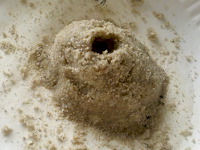Over the summer, two second-grade students found a large group of Yekttis living near one another. In observing these Yekttis, one of the students made sketches of all of the ones she saw. She noticed that while they were all similar, no two were exactly alike.
Using her sketches, we can play "Guess My Rule" - a game of sorting.
The first day we observed her sketches, we noticed that some attributes of the Yekttis changed. Some had ringed eyes and other had plain eyes. Some had one antennae, two antennae, three antennae, or even four antennae. Some had square-shaped heads, rhombus-shaped heads, hexagon-shaped heads, or triangle-shaped heads. We sorts piles and piles of these cards as a group first to get used to the process.
We then began our "Guess My Rule" game.
One student takes a rule card. It names one attribute of a Yektti. That student draws four Yektti cards and sorts them -- putting them inside a loop of yarn means they meet the rule. Putting them outside of loop of yarn means they do not meet the rule. In turn, students at the table draw another Yektti card and try to sort it correctly - even though they don't know the rule. After a few rounds, students can try to guess the rule. If you guess correctly, the game begins again with a new rule. If you guess incorrectly, you sit out that round and just observe. We shouldn't make hasty guesses we aren't positive of!
If you click HERE you can download all of the rule cards and Yektti cards for yourself. Have your child play at home - take turns being the person who knows the rule and the person who does not. It's a fun game that helps us sort information - a great skill as we move further into our data-collection unit.
































